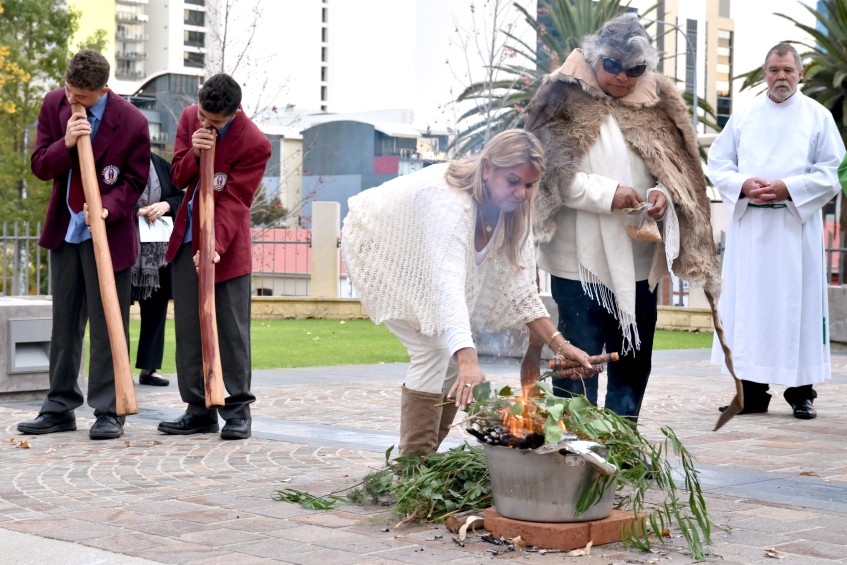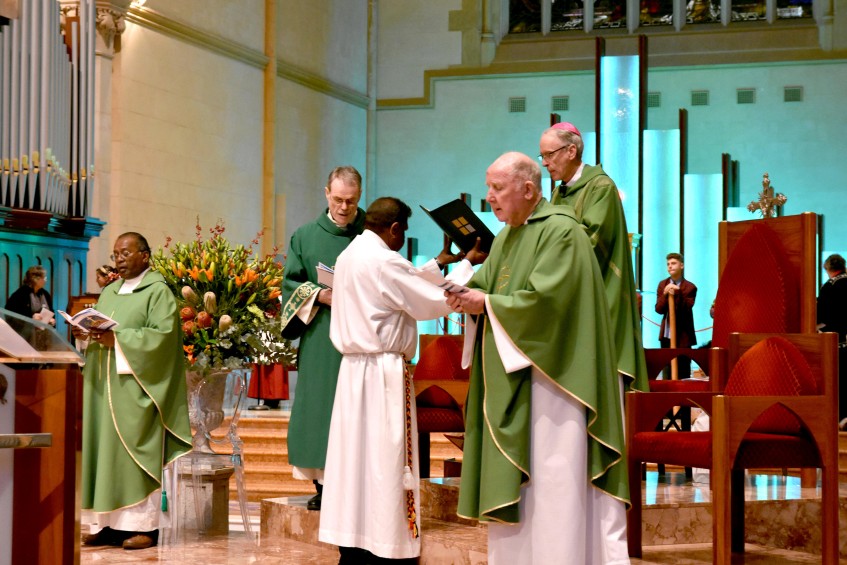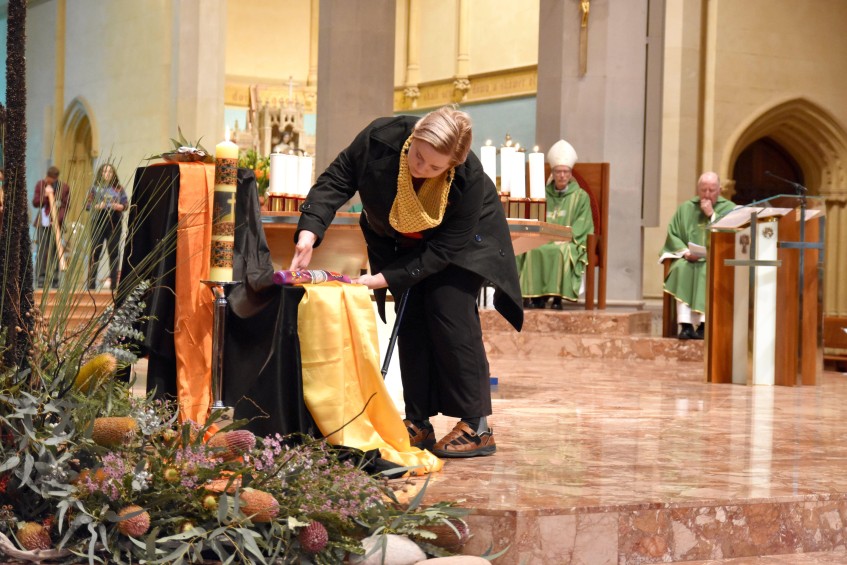NAIDOC Week final Mass recognises Indigenous contribution

Aboriginal elder Therese Walley and her daughter Rose add more leaves to the fire as part of the smoking ceremony for the end of NAIDOC Week Mass. Aboriginal students from Lumen Christi College Brandon and Thairon Jansen were playing the digeridoo in the background. Photo: Daniele Foti-Cuzzola.
By Caroline Smith
The Archdiocese of Perth marked the end of NAIDOC Week celebrations with a Mass at St Mary’s Cathedral which drew on aspects of Aboriginal culture to highlight the contribution of Indigenous communities to the Catholic Church in Australia.
The Mass – held on Sunday 9 July – was celebrated by Auxiliary Bishop Donald Sproxton and con-celebrated by Aboriginal Catholic Ministry (ACM) Chaplain Father Joseph Rathnaraj, Fr Ray Hevern SAC, Fr Conor Steadman as MC, Deacon Paul Reid and acolyte Reg Carnamah, who is an Aboriginal Pastoral Care Assistant with ACM.
The celebration began with a traditional smoking ceremony at the entrance of the Cathedral, where Aboriginal elder Therese Walley and her daughter Rose welcomed attendees and explained the significance of the tea tree, eucalyptus, peppermint and sandalwood branches that were burned in the ceremony.

The Mass to mark the end of NAIDOC Week was celebrated by Auxiliary Bishop Donald Sproxton and con-celebrated by Aboriginal Catholic Ministry (ACM) Chaplain Father Joseph Rathnaraj, Fr Ray Hevern SAC and Deacon Paul Reid, helped by Fr Conor Steadman and Acolyte Reg Carnamah, who is a Pastoral Care Assistant with ACM. Photo: Daniele Foti-Cuzzola.
In his homily, Bishop Sproxton said St Mary’s Cathedral was a fitting place for the Mass, since its congregation included people from around the world, ensuring that Aboriginal people, like others, would be welcome.
“Every effort is made to make St Mary’s Cathedral a place of welcome for everyone and the multicultural character of the congregations here bear out the fact that Catholics from many lands have made their spiritual home here,” he said.
“We hope that all communities will feel welcome here and that the communities of the first people of this land, above all, will feel this welcome too, and see this place as a spiritual home.”
The entrance procession included didgeridoos carried by Brandon and Thairon Jansen, together with clapping sticks which were also used in songs throughout the Mass.
A message stick was presented for display on the sanctuary by Juanita Spedding to introduce the Liturgy of the Word and readings were proclaimed by Diana Alteri from Catholic Education WA (CEWA) and Hayley Lewis, with the responsorial psalm proclaimed by Aboriginal Catholic Ministry Director Vicky Burrows.
The Prayers of the Faithful were proclaimed by Shirley Quaresimin and her daughter Andrea Lewis, with granddaughter Ayesha Lewis reciting the response in the Noongar language.
He added that the teachings of Jesus, which encourage people Christians to take on the ‘burden’ of love towards others could encourage greater engagement with Indigenous people and support reconciliation efforts.
“Jesus spoke of real love as being a yoke and burden. A yoke is the harness that is placed over the shoulders of a horse or bullock, and the load that is to be drawn is attached to the yoke. For the Christian, the yoke is our faith, our partnership with the Father and his Son Jesus,” Bishop Sproxton said.
“The burden is the commandment to love, to be compassionate, to seek to understand the others around us and to respond generously to them.
“Our Aboriginal and Torres Strait Islander brothers and sisters are seeking a new communion with all the people of our land of Australia. This is the time for reconciliation. We are challenged to come together as people of many nations, especially when under the influence of God’s Holy Spirit, to be one people, and to acknowledge that we are brothers and sisters in Christ above all else.”
After Communion, an Acknowledgement Plaque recognising Aboriginal people was blessed by Bishop Sproxton. The plaque will be placed at the entrance of the Cathedral.
Similar plaques have been presented to parishes and communities around Perth, including Hilton, Como, Armadale and Gosnells Parish, as well as Sacred Heart College Sorrento and at Melaleuca Women’s Prison.

A message stick is brought to the sanctuary by Juanita Spedding as part of the end of NAIDOC Week Mass on Sunday 9 July at St Mary’s Cathedral. Photo: Daniele Foti-Cuzzola.
Celebrations for NAIDOC Week in the Catholic community began with Aboriginal Sunday on 2 July, with several parishes across the Perth Archdiocese celebrating and acknowledging Aboriginal people and culture throughout their Liturgy. Art displays recognising Aboriginal culture were present in Hilton and Bunbury parishes, and message sticks were included at Armadale, Gosnells, Goomalling and Rockingham Parish, Rottnest Island Pastoral area, Catholic Agricultural College in Bindoon, St Jerome’s Primary School, St Joseph’s School Queens Park, Catholic Youth Ministry Offices Highgate, St Thomas More College in Crawley and St John of God Midland Hospital.
In Goomalling, celebrations for Aboriginal Sunday included a smoking ceremony at the beginning of Mass, special blessings throughout and a traditional meal to follow.
Bishop Sproxton also gave credit to the strong family bonds which exist within Aboriginal communities, referencing Bishop Christopher Saunders of Broome, who recently reflected on this topic.
“He has lived and worked with Aboriginal people for forty years, together with the priests, Religious and lay missionaries in the Kimberly. He traced the complex family arrangements for the care of the children that have been practiced for thousands of years,” Bishop Sproxton said.
“For example, there is a shared responsibility in the family for the care and upbringing of children. The mother’s sister is also considered to be the child’s mother too, and so with the father’s brother, he is considered to be a father to the child. There is a collective responsibility felt by the family in raising the children.
“Being able to observe Aboriginal family life today, the bishop wrote that despite ‘the devastating effects of colonisation, the dispossession of family country, and the accompanying social disconnection…the bonds of family life persevered and survived these overwhelming tribulations’. The sense of family remained strong.”
